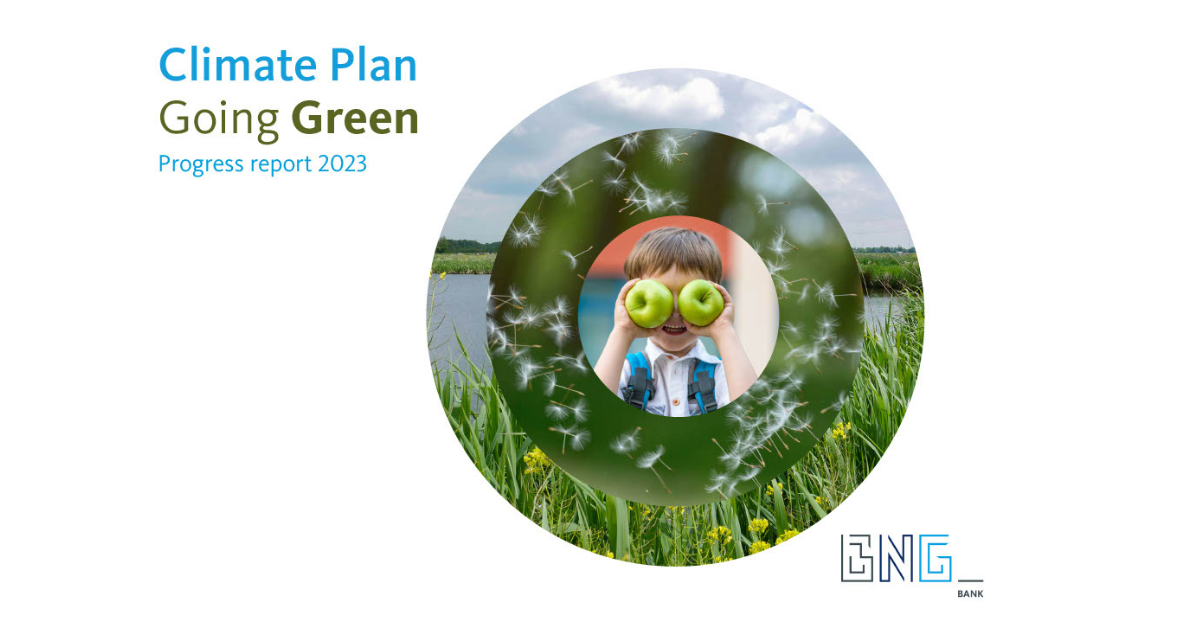Commitment to CO2e reduction pays off BNG sees client emissions fall
16 April 2024
The scope 1 and 2 emissions[1] of clients in the BNG loan portfolio fell by 9.5% in absolute terms in 2022[2] relative to 2021. Compared with the reference year 2018, this is a drop of 21.8%. BNG supports its clients with funding to achieve their climate targets for the transition to a CO2e-neutral society and actively engages in this transition with its ‘Going Green’ climate plan. BNG’s target of at least a 25% reduction in 2025 in terms of the scope 1 and 2 emissions of its loan portfolio now seems within reach.
Freya van der Kroef, Head of Strategy & Sustainability at BNG, calls the decrease in emissions ‘a hopeful development’. Driven by social impact, BNG is joining forces with the largest four sectors in which the bank operates – social housing associations, municipalities, healthcare and education – in order to reduce CO₂e emissions. Van der Kroef: ‘Although we’ve seen the public sector grow more ambitious when it comes to sustainability, our clients also face challenges in terms of realisation. While emissions from the real estate of municipalities are in line with the Paris Climate Agreement, it’s not self-evident that the healthcare institutions in our client portfolio will meet their 2030 target emission levels. It’s a positive sign that a large number of these clients have signed the “Green Deal for Healthcare”, underlining their commitment to making the healthcare system more sustainable. Thanks to its innovative financing solutions, BNG can make innovative projects possible. This is where we’ll realise our added value in the coming years.’
Carbon Risk Real Estate Monitor as the basis for targets
In order to gain insight into the level of CO₂e emissions required for BNG’s four main client groups to remain in line with the Paris Climate Agreement, BNG uses the decarbonisation pathways developed by the Carbon Risk Real Estate Monitor (CRREM). Emissions from BNG’s largest client group, social housing associations, are still slightly above the required emissions per m² to be in line with the 1.5 ˚C scenario. ‘Since social housing associations comprise half of our loan portfolio, we’ll continue to make every effort to help this client group increase its annual reduction in CO2e emissions,’ says Van der Kroef. Despite the large insulation challenges that school buildings face, emissions of educational institutions are lower than targeted in the decarbonization pathway. This outcome cannot be fully explained. BNG will investigate further next year.
Sustainability embedded in relationship management
Sustainability has been an integral part of client interviews since 2023. In 2024, BNG has started to analyse the extent to which its clients’ emission reduction plans are in line with their sectoral targets. This way, BNG is able to support and encourage clients in a focused manner to achieve their targets.
BNG office building makes positive contribution to the environment
BNG wants to take full responsibility for the footprint of its own business operations.
Energy consumption in the office building and mobility are the main sources of emissions. Emissions from BNG’s own office building are well in line with the 1.5 ˚C scenario. Moreover, BNG is going a step further: it is currently renovating its office building, which will soon contribute actively to the environment. Due for completion in 2025, the building itself will generate energy, buffer water, act as a resource bank, improve soil and increase biodiversity. Emissions from BNG lease cars fell by 27% in 2023 compared with 2022.
Read the 2023 progress report on the ‘Going Green’ climate plan here

[1] Scope 1: direct CO₂e emissions caused by sources internal to BNG client’s organisations. Scope 2: indirect CO₂e emissions from BNG clients’ business operations due to the purchase of electricity, heat and cooling. The scope 1 and 2 emissions of these clients currently represent 36% of their total calculated absolute emissions. The other 64% are mainly scope 3 emissions of the municipalities in the loan portfolio. The clients’ scope 3 emissions have not yet been included in the reduction targets for 2025 and 2030.
[2] Due to the delay in data availability, the most recent year for which BNG is able to present financed emissions is 2022. These financed emissions were calculated for 90% of the loan portfolio. BNG has not yet mapped out any emissions for the other portfolios on the balance sheet.
-
Frederike Versloot, Spokesperson
